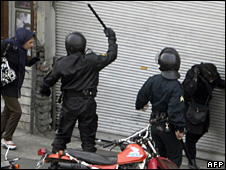
The Green Movement says more than 70 of its supporters have been killed
How did the crisis in Iran begin? It all started when the re-election of President Mahmoud Ahmadinejad in June was disputed by the three defeated candidates - all establishment figures in Iran. Two of them, former Prime Minister Mir Hussein Mousavi and the former speaker of parliament and senior cleric, Mehdi Karroubi, have since become leaders of the nationwide opposition Green Movement, after its signature colour. They and millions of Iranians demanded a re-run at mass protests that drew the largest crowds since the Islamic Revolution in 1979. However, the country's Supreme Leader, Ayatollah Ali Khamenei, insisted the result was valid and Mr Ahmadinejad was sworn in for a second term in August.

Protesters are becoming fearless in the face of state repression
|
Despite increased security, official warnings and often brutal crackdowns on opposition figures, journalists and ordinary demonstrators, the Green Movement has continued to protest against the result and demand the president resign. Tens of thousands of opposition supporters clashed with the security forces and members of pro-government militia on Quds (Jerusalem) Day in September, the 30th anniversary of the storming of the US embassy in Tehran in November, and on National Students Day at the start of December. The Green Movement says more than 70 of its supporters have been killed since June, a figure the authorities dispute. At least five people have been sentenced to death, and dozens imprisoned. The death on 20 December of Grand Ayatollah Hoseyn Ali Montazeri, a long-time and influential critic of Iran's leaders, gave new impetus to the opposition. There were further violent anti-government protests across the country 10 days later on Ashura, one of the holiest days in the Shia Muslim calendar. At least eight people were killed in Tehran and Tabriz, including Mr Mousavi's nephew. What next for the protesters? The opposition has adopted the tactic of using the relative safety of officially-sanctioned demonstrations on important days in the religious and political calendar to come out in big numbers and turn the official rallies into a show of force of its own, with an entirely different and opposing set of slogans.

Protesters have used officially sanctioned rallies to make their mark
|
They did this on Quds Day, the anniversary of the seizure of US embassy, National Students Day and Ashura, despite warnings by the government that unauthorised demonstrations would be put down. The opposition leaders have promised to use similar occasions in the future to come out on the streets to voice their demands for change. The violent response of the protesters to the security forces on Ashura - attacking troops with their bare hands, throwing stones and setting police cars on fire - also suggests many are becoming fearless in the face of repression. The authorities have not sought to target either Mr Mousavi or Mr Karroubi, but have instead arrested many of their closest aides and family members. Members of the government of former President Mohammed Khatami, a prominent reformist, have also been detained, as have journalists and human rights activists. But BBC Tehran correspondent Jon Leyne says neither side appears to have a clear strategy of what to do next. The opposition is leaderless, while the government is still pretending there are just a handful of troublemakers, he says. What is going on behind the scenes? There is a good deal of debate within the government, and the Islamic authorities as a whole, as to how to deal with the opposition. So far, the hardliners have had the upper hand. They have ordered a crackdown on the Green Movement in the hope that this will force it off the streets and prevent upheaval like the recent pro-Western "colour revolutions" in Eastern Europe. However, the continued show of defiance has undermined them. Several powerful members of the establishment, including former President Akbar Hashemi Rafsanjani, have criticised the authorities and called for reconciliation. Opposition leaders have warned that the government, feeling the pressure from within Iran, might choose to make concessions abroad on international issues. There have been signs that President Ahmadinejad and his supporters may be pursuing a different and more conciliatory line to that of Ayatollah Khamenei on Iran's dispute with the international community over its nuclear issue. How is Iran divided? There is growing divide between the government and the regime as a whole on one side and a good number of Iranians on the other. The opposition demonstrators have been directing a lot of their anger at Ayatollah Khamenei, some even calling for him to be replaced. He is seen by them as the power behind the crackdown, Mr Ahmadinejad's disputed re-election, and behind many of the president's domestic and foreign polices which have brought more hardship to Iranians. The fact that the demonstrations are now regularly taking place in cities other than just the capital, Tehran, is not a comforting sign for the government. Can Ayatollah Khamenei be challenged? Under Iran's form of government, known as Velayat e-Faqih - rule of the jurist in Farsi - the Supreme Leader has far-reaching powers. He appoints the head of the judiciary, six of the members of the powerful Guardian Council, the commanders of all the armed forces, Friday prayer leaders and the head of radio and TV. He also confirms the president's election. In theory, the Supreme Leader could be dismissed by the Assembly of Experts, an elected body of Islamic scholars currently chaired by Mr Rafsanjani. However, it has never before questioned the authority of Ayatollah Khamenei or his predecessor, Ayatollah Ruhollah Khomeini.
|

~RS~q~RS~~RS~z~RS~49~RS~)







Bookmark with:
What are these?